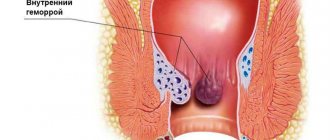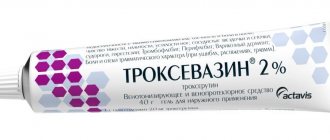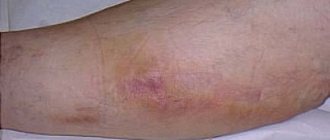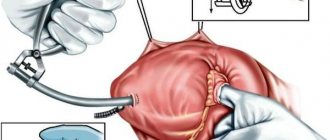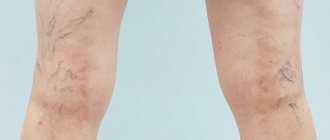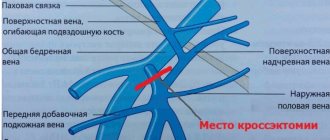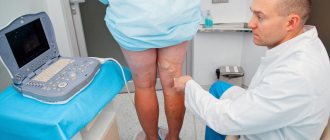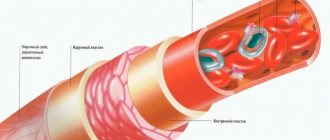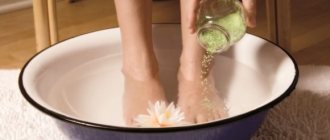An increase in pressure in the blood vessels can lead to the formation of trophic ulcers. Varicose veins can be complicated by thrombosis and thrombophlebitis - a condition when blood clots (thrombi) form inside the veins, interfering with the free movement of blood throughout the body. The most dangerous consequence, even death, is considered to be thromboembolism - the separation of a blood clot, as a result of which the clot clogs the artery of the pulmonary circulation.
When the first symptoms of varicose veins appear (swelling and heaviness in the legs, the appearance of spider veins, dilated veins in the legs), you should consult a phlebologist. This will allow you to timely identify the essence of the problem - by performing an ultrasound of the veins, begin treatment and prevent complications.
How are the veins in the legs arranged?
The legs have two groups of venous vessels: superficial and deep or deep. The first are located in the subcutaneous tissue, that is, on the surface of the leg. The latter are located deeper, in the thickness of the muscles, next to the arteries and tendons. The deep and superficial vessels are connected by perforating or perforating veins. Their wall consists of collagen and elastin fibers, with weak and few smooth muscles. The venous wall has a three-layer structure:
- At the top is the adventitia, which is composed of loose connective fibers, smooth muscle cells elongated along the walls, surrounded by small capillaries and nerves responsible for the trophism of the vessel.
- In the middle is the media, consisting of circular smooth muscle fibers.
- The intima is located on the inside. The basis of the intima is the endothelium; between its cells there are longitudinal fibers of smooth muscles. The inner shell is folded, the thickenings are opposite each other and resemble swallows' nests or patch pockets. They are called valves and are responsible for the correct direction of blood flow.
Venous valves direct blood from the peripheral parts to the heart, as well as from the superficial to the deep veins. They prevent reverse outflow and increase venous pressure. In addition to the valves, smooth muscles, tendons and muscles of the leg take part in maintaining normal tone. When any of the layers (usually the median and internal layers) are damaged, the veins lose their tone and expand, and varicose veins occur.
- There are several superficial veins:
- The great saphenous vein is located on the inside of the leg; its walls are equipped with several valves; blood from the anterior femoral surface is collected into this vein through a series of smaller vessels.
- The small saphenous vein is located on the outside of the leg, equipped with valves, and collects blood from the veins on the front and back of the leg.
Communication between the large and small veins occurs through connecting vessels.
- The deep veins are the posterior and anterior tibial veins, the popliteal vein, and the femoral vein. Varicose veins develop in them at advanced stages, when the disease is not treated for a long time.
Symptoms and manifestations of varicose veins at the initial stage
The symptoms of initial varicose veins depend on the diameter of the affected vessels and their significance for the general venous outflow. The “cosmetic” type of the disease is characterized by the presence of only external defects in the form of spider veins (telangiectasia) or a superficial fine mesh. There cannot be any other complaints, since the affected vessels have a very small diameter and are responsible for draining blood only from certain areas of the skin. With the classic version of varicose veins, the symptoms are more obvious, although physical discomfort in the early stages of the disease is not permanent. The quality of life does not deteriorate significantly, and no serious complications arise. In this form, varicose veins can exist for quite a long time, decompensating and progressing with the addition of additional risk factors.
Severe symptoms of varicose veins
Symptoms of varicose veins affecting the saphenous veins of the legs include (8, English):
- Increased venous pattern in the lower extremities. There is a change in the course of visible superficial vessels and their bulging. But with obesity, this symptom is often masked by overdeveloped subcutaneous tissue. Obvious nodular deformation of blood vessels usually develops in later stages of the disease.
- The appearance of heaviness, a feeling of fullness and fatigue in the legs are signs of decompensation of venous insufficiency. They are usually accompanied by a tendency to slight swelling (pasty) of the legs. Such complaints may appear towards the end of the working day, especially if professional activities involve prolonged standing or sitting. In the early stages of varicose veins, discomfort and swelling disappear soon after taking a horizontal position with legs elevated. Facilitates the condition and performance of a set of exercises to engage the muscle pump of the legs.
- Increased fatigue of the leg muscles, and in some patients a tendency to cramps. This is explained by the beginning of metabolic changes in tissues, which are caused by microcirculation disorders against the background of phlebostasis.
The severity of symptoms may vary. In some patients, varicose veins in the initial stage debut with visible changes in the superficial veins. In others, signs of venous insufficiency initially appear, which is a sign of already existing valve pathology and serves as an indicator of a less favorable course of varicose veins.
For what reasons does varicose veins appear, and who is at risk of getting sick?
It is difficult to say why people get varicose veins at the moment. Only a number of risk factors have been identified, due to which the valves weaken and the elasticity and tone of the walls of the superficial and perforating veins decrease.
Here are the factors that lead to the development of the disease:
- Heredity. The structure of the walls of blood vessels is determined genetically; with some changes in the genes, they weaken and the valves do not close well. As a result, with the slightest increase in pressure in the veins, a reverse outflow of blood occurs, the vessels overflow and expand.
- Hormonal changes in the body in women. This situation is typical for pregnant women or for the second half of the cycle, when the amount of progesterone increases and the level of estrogen decreases. As a result, blood rheology changes (coagulability increases), vascular tone decreases, elastin and collagen fibers are destroyed, and the risk of blood clots increases.
- Obesity. People who are overweight move little, which slows down blood flow throughout the body. Excess subcutaneous fat on the abdomen leads to increased pressure in the abdominal cavity and compression of the main veins. This leads to stagnation of blood in the vessels of the legs, and further to varicose veins.
- Diabetes. Sugar, the level of which increases in this disease, damages the vascular endothelium, which increases the risk of blood clots.
- Alcoholism. When drinking large doses of alcohol, dehydration occurs, the blood thickens, clots form, clogging small blood vessels and causing congestion.
- Static occupational loads, such as lifting heavy loads, standing or sitting work. In such a situation, muscle tone drops, blood moves worse from the lower extremities to the heart, stagnation occurs, and the veins in the legs dilate because of this.
- Congenital pathologies of blood clotting. Hypercoagulation, in which too many factors are produced that are responsible for the formation of clots in the blood, provokes thrombosis and impedes the movement of blood through the vessels.
- Wrong diet. A diet deficient in a number of vitamins (C, E, PP) and plant fiber leads to disturbances in the structure of the endothelium and other structural elements of the vascular walls.
- Tight underwear. When wearing tight underwear, some of the veins are pinched, which causes obstructed blood flow from the lower half of the body.
- Frequent constipation. People suffering from this problem have to constantly push, this increases the pressure inside the abdomen, as a result, the outflow of blood becomes difficult.
- High heel. Overstraining the calf muscles and insufficient contraction causes blood to stagnate in the veins.
- Hot climate. In summer, during the heat, the body becomes dehydrated. If you do not compensate for the problem by drinking a sufficient volume of fluid, the risk of blood clots in the vessels will increase.
- Pathologies of the heart and kidneys. These may be congenital or acquired heart defects, renal failure.
- Exceeding doses of medications that affect coagulation. In this case, the blood vessels may become clogged with blood clots.
- Operation. The risk of thrombosis in this case increases due to blood loss and compression of veins during the intervention.
The most effective ointments and gels against varicose veins.
June 23, 2021
63326
4.8
3
Content
- Why do varicose veins develop?
- What are the symptoms of varicose veins?
- The best ointments for varicose veins
- Heparin ointment
- Indomethacin
- Lyoton
- Phlebodia
- Hepatrombin
- Troxevasin
- Diclogen
- Venitan
- Detragel
With varicose veins, the vessels that carry blood to the heart (usually in the lower extremities) become irreversibly dilated and/or lengthened. The veins usually become thin and knots form in them.
Varicose veins are a common disease: every third woman and every tenth man on the planet suffers from it. Moreover, the problem most often develops at a young, most able-bodied age - at 30-40 years old.
How can varicose veins be complicated?
- Thrombosis due to blood stagnation.
- Vascular thromboembolism as a result of blood clot detachment.
- Thrombophlebitis or inflammation of the venous wall.
- PE (pulmonary embolism). In this case, blood flow in the pulmonary circulation is sharply disrupted, which leads to death. Small blood clots can lodge in the small pulmonary arteries and cause a heart attack or pulmonary edema.
- Trophic ulcers, eczema on the skin of the legs due to tissue malnutrition. With poor blood circulation, little oxygen and nutrients enter the tissues, which impairs regeneration or causes massive cell necrosis.
- Edema syndrome. As a result of impaired blood outflow and stagnation, fluid leaks through the walls of blood vessels into the intercellular space. The swelling is soft in consistency, elastic, and most often appears near the affected vein, regardless of the time of day.
- Dermatitis. The inflammatory process in the skin develops due to impaired blood flow and tissue nutrition.
- Hyperpigmentation, cyanosis of the affected areas of the skin.
- Consolidation of subcutaneous fat due to swelling and hemorrhage.
Why do varicose veins develop?
Varicose veins can be successfully treated if diagnosed in time. Some of the causes of varicose veins include:
- Genetic predisposition. A person is prone to developing varicose veins if his immediate relatives had a similar problem.
- Floor. Varicose veins are more common in women than in men. One of the risk factors for the development of varicose veins in women is pregnancy, when there is increased stress on the legs.
- Wrong lifestyle. Varicose veins develop due to increased venous pressure. It, in turn, is caused by factors such as decreased physical activity, excess weight, static loads in an upright position, etc. Read also Top 10 best blood thinners Blood thinners
There is also a list of certain factors that provoke varicose veins:
- elderly age;
- professional activities when a person is forced to stand for a long time (dentists, hairdressers, salespeople);
- prolonged paroxysmal cough;
- chronic constipation;
- lifting something heavy;
- hormonal imbalance in women.
How to diagnose varicose veins
- Using functional tests (application of a tourniquet), the condition of the valves is studied. They are named after the authors - Troyanov-Trendelenburg, Pratt, Sheinis, Delbe-Perthes, etc.. For the Troyanov-Trendelenburg test, you need to lay the patient horizontally, then offer to raise the leg 450. In this position, the doctor strokes the limb from the foot upward to empty the superficial veins. The next step is to apply a tourniquet to the upper half of the thigh, after which the patient rises from the couch. Healthy veins in the legs should fill up after 15 seconds.
- Duplex ultrasound scanning of veins (ultrasound angioscanning) provides the most information and allows you to visualize the vessels and blood flow through them.
- Dopplerography is a method for assessing blood circulation through vessels.
- Phlebography or X-ray examination using contrast, which helps to study the internal structure of the vessel.
- Phleboscintigraphy is a technique using radioactive substances with further study on a special device for their distribution.
To study the superficial veins, they are examined and palpated. The first three methods are used as additional examinations. The last two methods are necessary to study the condition of the deep or deep veins.
Diagnostics
Diagnosis of varicose veins, determination of the nature and severity of hemodynamic disorders in the veins of the legs is the prerogative of a phlebologist.
Diagnosis of initial varicose veins includes (9, English):
- clinical examination with functional tests;
- Ultrasound Doppler Doppler (USD) of the vessels of the lower extremities to assess the nature of blood flow and identify valvular insufficiency in superficial veins and perforators;
- if necessary, consultations with other specialists (gynecologist, endocrinologist, gastroenterologist) and tests to determine the main causative factor in the development of venous hypertension.
Invasive diagnostic techniques are currently practically not used, since the information obtained with their help does not have much clinical significance. An ultrasound scan is usually sufficient.
Treatment of varicose veins
Conservative treatment options
- Drug therapy does not cure varicose veins, but with the help of drugs, valve function, vascular trophism, blood circulation are partially improved, and the risk of thrombosis is reduced.
For this purpose, venotonics are used (Detralex, Troxivazin, Lyoton gel, etc.). They can be prescribed for any type of varicose veins. Ointments with nonsteroidal anti-inflammatory drugs (Indomethacin, Diclofenac, etc.) are indicated for thrombophlebitis. Also in this situation, anticoagulants are used (Heparin, Clexane, Fraxiparine, etc.), which effectively resolve blood clots. Treatment should be selected by a doctor, after a thorough diagnosis and taking into account the characteristics of the patient. - Herbal medicine and additional techniques are of auxiliary value. It is advised to wear compression stockings, do gymnastics, skiing, cycling, and swimming. The “bicycle” exercise in a supine position, flexion and extension of the feet, gives good results; it improves the outflow of blood from the extremities. You can do the exercises if there are no complications. It is also recommended to take a contrast shower in the morning (water your leg first with warm water, then gradually reduce the temperature to cold). Cool baths with decoctions of oak bark, horse chestnut, chamomile, St. John's wort, rubbing the skin with tincture of white acacia flowers, Kalanchoe leaves, and apple cider vinegar help. Leeches help get rid of thrombophlebitis.
- Mode. You need to get out of bed slowly, 5-10 minutes. Your legs should be raised 10-15⁰ at night; to do this, place a cushion under your heels. You need to walk calmly, it is undesirable to cross your legs when sitting, and do not overwork. All patients are advised to wear compression stockings.
- You need to eat right, include coarse fiber and foods rich in vitamins in your menu. Citrus fruits, tomatoes, rose hips, black currants, nuts, legumes, liver, onions, eggs, and seafood will be useful. It is important not to drink alcohol, not to smoke, and to drink enough water during the day. For persistent constipation, it is recommended to drink a laxative.
Surgery
Phlebectomy or complete removal of veins
The indication for such a radical operation is varicose veins, which involve a large number of veins. At the same time, there are complications - trophic ulcers that are difficult to treat, thrombophlebitis, persistent swelling in the legs, general symptoms (fatigue, dizziness, fainting).
The operation is contraindicated in case of ischemic heart disease, severe infections, in very old patients, in the second half of pregnancy, in case of local inflammation of the legs (erysipelas, pustular rashes, eczema). Only surgery can radically rid the patient of varicose veins and restore the function of the valves. If the situation is too severe, untreated and neglected, this method of treatment remains the only one. The disadvantages of the intervention are the need to give anesthesia and keep the patient in the hospital for several days under observation, postoperative trauma with scars.
Laser therapy (endovascular microthermocoagulation)
Laser treatment of varicose veins is used if the pathology is combined with diseases of the cardiovascular system (CHI, hypertension), changes in peripheral vessels (phlebitis, thrombophlebitis), diseases of the respiratory system (asthma, chronic bronchitis, pleurisy), gastrointestinal pathologies (cholecystitis, ulcers, peritonitis ), nervous system (FM injuries, meningitis, encephalitis and their consequences), genitourinary system (inflammation of the kidneys, prostate, pathology of the uterus with appendages), with skin diseases (furunculosis, dermatitis, psoriasis, etc.).
Contraindications to the use of laser are oncology, decompensated pathology of the kidneys, liver, heart, cerebral sclerosis, pregnancy.
The main advantages of laser therapy are its effectiveness in eliminating dilation of superficial veins, speed (duration of manipulation is 15-20 minutes), no need to go to the hospital, and low trauma. Among the disadvantages, it is worth highlighting the poor accessibility of the technique; not all clinics have the appropriate equipment. Treatment is expensive and is of little use for severely affected and deep veins. If the laser is used incorrectly, you can get a thermal burn, and sometimes depigmentation occurs at the sites of exposure.
Radiofrequency coagulation (ablation)
The operation is indicated for extensive lesions of the saphenous veins, trophic ulcers resulting from long-term and untreated varicose veins.
Radiofrequency coagulation is contraindicated in acute thrombophlebitis, limited mobility of the patient, pregnancy, and mental disorders.
The main advantages of the method are its painlessness, absence of injury, and the need for hospital stay. Patients can return to normal activities the very next day.
The disadvantage is the high cost of the intervention.
Sclerotherapy
Indicated for varicose veins of small and large superficial veins (on large vessels it is carried out under the control of duplex Doppler ultrasound) in the initial stage and without complications. Pregnant and nursing mothers, allergies to drugs, deep vein thrombosis, infectious and inflammatory skin lesions on the legs are not treated with this method. The main advantages are low price, quick recovery, no need for hospitalization. The procedure leaves no marks and does not cause injury.
The disadvantage is the risk of the sclerosing drug entering a deep vein, reduced effectiveness upon contact with blood, and the ability to use only in the initial stages.
Possible complications
Deformed veins and the sclerotic valves located in them are not able to recover to their original level under the influence of drug therapy. The changes are irreversible and prone to progression, especially when provoking factors persist and new adverse effects are added. In the initial stages of the disease, developing venous insufficiency can decompensate - this does not indicate getting rid of varicose veins, but a temporary slowdown in the pathological process. Subsequently, adjacent sections of the vein and other vessels are involved in phlebosclerosis. The greatest clinical significance is the damage to the communicating veins, which provide communication between the superficial venous network of the legs and the deep one. They penetrate (perforate) the fascia located on top of the muscles, therefore they are also called perforators. Most communicating vessels also have valves, which normally prevent the non-physiological discharge of blood from deep veins to superficial ones, therefore varicose changes in perforators are accompanied by the development of horizontal reflux. This shutdown of the natural mechanism for regulating pressure in the superficial venous system leads to serious consequences:
What happens if varicose veins are not treated?
Turning off the natural mechanism for regulating pressure in the superficial venous system leads to serious consequences (11, German):
- worsening phlebosclerosis and accelerating the process of varicose veins against the background of significantly increased venous hypertension;
- increased phlebostasis, which increases the likelihood of developing intravascular thrombosis;
- disruption of the walls of the capillary network, which is accompanied by an increase in their permeability to plasma and protein molecules, accumulation of metabolic products in tissues and the development of chronic hypoxia.
The addition of horizontal reflux is a factor contributing to persistent decompensation of chronic venous insufficiency. Trophic disorders arise and increase in the skin and soft tissues, swelling and physical discomfort experienced by the patient increase, and the risk of developing thrombophlebitis increases. Varicose veins become complicated, advanced, with a significant area of damage to the veins. And the treatment will no longer give as quick and tangible results as at the early stage.
Is it possible to cure varicose veins at home?
At home, it is allowed to use auxiliary methods for treating varicose veins, which alleviate symptoms. They use ointments from pharmacies or self-prepared ones, baths and lotions based on herbs, compresses, drink decoctions and infusions to improve blood flow and relieve swelling. Below are some recipes.
Chestnut tincture
Take about 200 g of ripened and peeled chestnuts. Pass through a meat grinder or grind with a blender. Fill everything with a liter of vodka, put it in a dark corner and leave for a couple of weeks. To make the product smell good, add a couple of drops of peppermint oil. In the evening, lubricate the legs with the tincture to get rid of heaviness and itching, strengthen blood vessels, and prevent their fragility. It is also recommended to make a compress from the tincture. If there is no chestnut, it is replaced with nutmeg, the recipe remains the same. Tincture with musk nuts can not only be used to rub sore feet; it is recommended to drink 20 drops a day. After the bottle is finished, a new tincture is made. But there should be a pause of 2 weeks between taking the next portion.
Calendula-based ointment
An infusion is made from calendula flowers - pour a tablespoon of boiling water, put on fire, cook for a couple of minutes, leave for 3 hours in a thermos. Strain the infusion and add it to some kind of fat; lanolin, Vaseline, badger fat are suitable. For the smell, it is recommended to add a drop of aromatic oil (rose, bergamot, citrus, sage, lavender, etc.) Rub the ointment in the morning and evening, with gentle movements from the bottom of the leg to the knee, until completely absorbed. Thyme, hop cones, and nettle are also added to the calendula infusion.
Chamomile oil
Medicinal chamomile flowers are placed in a half-liter glass jar of a dark shade so that the container is filled to the top. Pour in half a liter of any type of vegetable oil, for example, from olives, corn, hemp. Leave for a month, shaking or stirring from time to time. After this, the oil infusion is filtered. For scent, add a couple drops of tea tree, mint, lavender, and grapefruit aroma oil. Apply chamomile oil to the foot early in the morning and late in the evening, while simultaneously doing a light massage. You can also make night compresses from the infusion.
Compress based on wormwood
Take a package of kefir or fermented baked milk, 3 tablespoons of dried wormwood. The grass is crushed and mixed with kefir (ryazhenka). When the grass is wet, place it on cheesecloth along with a thick liquid. Then a compress is applied to the leg, covered with wax paper on top (cellophane film is not used), and everything is fixed with several layers of bandage. Keep your legs elevated and remove the compress after half an hour. It is recommended to do the procedure twice a day. Instead of wormwood, you can take hops, chamomile flowers, string, clover, oak or birch leaves, St. John's wort, horsetail, tricolor violet flowers, yarrow. Combinations of different plants give a good effect. To improve the effect of the compress after the procedure, it is recommended to lie down for a while with your legs raised up. All of the herbs listed can be infused and used to make a foot bath. The water in such a bath should be warm, the duration of the procedure is about 25 minutes. It relieves fatigue, swelling, reduces skin itching and pain.
Traditional recipes for internal use
Various herbal infusions improve blood flow in the veins well. The following herbs are used:
- Clover
- in succession
- Leaves and berries of lingonberries, viburnum, strawberries, raspberries
- Coltsfoot
- Calendula
- Japanese Sophora
- Melissa
- Schisandra
- Hawthorn
The grass is dried, then crushed and made into a mixture of different types of plants. Then take 3 tablespoons, pour a liter of boiling water, leave overnight in a thermos and drink 1/3 glass before meals.
Varicose veins are well treated with bee pollen and honey. Pollen should be consumed internally. Honey can also be eaten, but it still makes good compresses. It is recommended to add infusions of various herbs to honey.
Venitan
Venitan gel for varicose veins contains the active substance escin (horse chestnut extract). "Venitan" strengthens the capillaries of the soft tissues of the legs, being a venotonic. "Venitan" for varicose veins reduces swelling and aching in the legs, heaviness, and stimulates venous circulation. Escin reduces capillary permeability and improves the functioning of the internal deep veins of the lower extremities. Venitan is usually prescribed for the treatment of early stages of varicose veins, although this gel is also effective for chronic vein problems. Apply Venitan gel to the skin with light movements three times a day.
Venitan
Sandoz, Germany
Venitan is an angioprotective drug for external use.
from 211
690
- Like
- Write a review
Treatment of varicose veins in pregnant women
Carrying a baby is accompanied by a hormonal storm in the female body and overload, which often provokes varicose veins. Treatment during this period is carried out conservatively, with the help of local creams, ointments and gels. The most effective ointments have a decongestant effect and eliminate heaviness in the limbs. Asklesan, Venorutin, Lyoton give good results. Apply them in a thin layer, moving from bottom to top, with soft massage movements. The frequency of manipulations is 1-3 times a day.
Folk remedies also help. It is recommended to prepare baths with herbal decoctions (from chamomile, thyme, hop cones, calendula, wormwood, coltsfoot, oak bark, birch leaves, etc.).
You can fight swelling by applying cabbage leaves or raw grated potatoes to your feet. You need to cover the compress with waxed or regular thick paper, not cellophane, so that the skin can breathe. The procedure is done before bedtime and the lotion is left overnight.
Doctors also prescribe medications for internal use to pregnant women. There are venotonics that do not negatively affect the development of the fetus and the health of the mother. They are most often based on plant extracts. Here are some popular drugs:
- Antistax
- Venoruton
- Troxevasin
- Detralex
- Vasocket
- Phlebodia
- Aescusan
After taking the medications, venous tone increases, the walls become elastic, they don’t stretch as much, lymph flow improves, the liquid part of the blood stops leaking into the intercellular space, and swelling goes away. You cannot take these medications without a doctor's prescription.
Diclogen
"Diclogen" for varicose veins contains diclofenac and belongs to the group of NSAID drugs. This is not an anticoagulant; it does not prevent blood from entering the tissues. But at the same time, Diclogen reduces the likelihood of secondary inflammation that develops with varicose veins. After all, all processes of swelling and fluid stagnation deform the venous valves. It is in these cases that Diclogen gel, or more precisely, diclofenac in its composition, comes to the aid of varicose veins. “Diclogen” against varicose veins perfectly relieves inflammation, redness of the skin, swelling of the legs, and reduces pain (especially if the stage of varicose veins has already developed when there is varicose dermatitis). "Diclogen" is prescribed for progressive chronic varicose veins. The course of treatment with Diclogen is 2 weeks, the gel for varicose veins is rubbed into the skin up to 4 times a day.
Diclogen
AGIO Pharmaceuticals Ltd., India
Combined anti-inflammatory drug.
It has a local analgesic, anti-inflammatory and anti-exudative effect. When applied topically, it reduces pain and inflammation in the joints, morning stiffness and swelling of the joints, and helps increase range of motion. It also causes irritation of nerve endings, has a local distracting and mild analgesic effect, and causes a feeling of coolness at the site of application of the drug due to menthol. from 23
5.0 1 review
361
- Like
- Write a review
Effective external remedies for the treatment of varicose veins
External remedies are not able to cure varicose veins completely, but they slow down the process and relieve some symptoms. In the initial stages, they can be the main treatment.
| № | Medicine | Mechanism of action | Method of use, effectiveness |
| 1 | Venitan Forte Suitable for use with compression garments. | Relieves inflammation, improves vein tone, reduces the risk of thrombosis, and heals wounds. | Apply to the leg from bottom to top, with gentle massage movements 1 to 3 times a day. If there is a trophic ulcer on the leg, ointment is applied along the edges. Course - 8 weeks. Heaviness in the limbs decreases, swelling and pain disappear. |
| 2 | Gepatrombin Allowed for use together with compression garments. | Activates blood flow, lymph flow, removes toxic metabolic products, improves skin trophism. | The ointment is applied to the area of the affected vein in the form of a strip, about 5 cm long. Then rubbed in lightly, moving from bottom to top. If the vein is inflamed, the ointment is not rubbed in, but applied like a bandage. The treatment reduces swelling, relieves leg fatigue and a feeling of heaviness, eliminates cramps and spasms in the calves, and promotes the healing of skin ulcers. |
| 3 | Troxevasin | Eliminates capillary fragility, reduces the permeability of venous walls, relieves inflammation, and prevents thrombosis. | Rub into the skin through a light massage, without touching areas with wounds and ulcers. After use, swelling, pain, and cramps disappear. The healing of trophic ulcers accelerates. |
| 4 | Essaven gel | Improves blood rheology, reduces blood clotting, has an anti-inflammatory effect, strengthens the walls of blood vessels, and improves tissue trophism. | Apply a couple of times a day to the skin over the affected veins. Swelling becomes less pronounced, heaviness, fatigue of the legs, convulsive contractions of the calf muscles disappear, and ulcers heal. |
| 5 | Lyoton 1000 gel, Lyogel | It improves blood flow in small veins, reduces the likelihood of blood clots, has an analgesic effect, and relieves edema. | A strip of gel, 30-10 cm long, is applied along the affected vein and rubbed in with a gentle movement. Relieves fatigue and heaviness in the legs, cramps in the calves, eliminates swelling. |
| 6 | Fastum-gel | It has analgesic, anti-edematous and anti-inflammatory effects, reduces the permeability of venous walls. | A strip of gel, 3-5 cm long, is applied along the diseased vein. Lubricate the leg 1-2 times a day, the course should last at least 3 weeks. The gel helps eliminate swelling, a feeling of heaviness, and fatigue. |
| 7 | Heparin ointment | A good remedy for the prevention of thrombosis, reduces blood clotting and vascular permeability. | A thin layer is applied to the leg and applied twice a day. Swelling decreases and the risk of blood clots decreases. |
| 8 | Ginkor gel | It has a positive effect on vascular tone, reduces their permeability, and improves tissue trophism. | Apply a small volume of gel to the skin 2-4 times a day for 4 weeks. After use, swelling, pain, seizures, heaviness and a feeling of numbness in the legs disappear. |
Treatment
The treatment methods used for varicose veins are divided into conservative and surgical. Typically, a treatment regimen includes both of these components. For the treatment of varicose veins at the initial stage, drugs of various groups are widely used, with preference given to phlebotonics in tablet form and as part of ointments. Their regular use in most cases makes it possible to compensate for incipient venous insufficiency, which has a beneficial effect on the patient’s condition (English). Some medicinal plants have approximately the same effect, which explains the frequent use of herbal medicine - both in the form of decoctions and infusions for oral administration, and in the form of herbal preparations. In addition to drug treatment, the following may be used:
- physiotherapy;
- compression jersey;
- exercise therapy;
- diet therapy - normalizing body weight will reduce the load on the vessels of the lower extremities.
All conservative methods have only a restraining and compensating effect. No drug is capable of restoring sclerotic and deformed veins and the valves located in them. At the initial stage, an excellent effect can be obtained with sclerotherapy; varicose veins of large diameter are eliminated with a laser - both treatment technologies will relieve not only the unsightly looking vessel, but also the existing venous insufficiency. Healthy deep veins take over the drainage of venous blood. After a short period of adaptation, the blood flow system is completely compensated, phlebostasis is stopped, microcirculation is normalized.
Effective creams for the treatment of varicose veins
Creams for the treatment of varicose veins are used only at the very beginning of the development of pathology. The following products have proven effectiveness:
| № | Medicine | Mechanism of action | How to use and how it helps |
| 1 | Cyclo 3 cream | The effect is associated with a decrease in blood clotting and an improvement in its rheological properties. Has an anti-inflammatory effect, normalizes lymph flow and blood flow. | The cream is applied to the leg after sleep and in the evening, while simultaneously doing a massage for 2-3 minutes, moving from the heel to the knee. After use, heaviness, numbness, and cramps in the calves disappear, swelling and pain are significantly reduced. |
| 2 | Girudoven | Strengthens the walls of veins, corrects their permeability, partially dissolves blood clots and prevents their formation. | You can lubricate your feet with cream or gel up to 5 times a day, using a small amount of the drug. Swelling, pain, fatigue and heaviness of the limbs disappear. The skin color is evened out and it becomes elastic. |
| 3 | Venitan cream Suitable for combined use with compression garments. | Eliminates inflammation, prevents thrombus formation, strengthens the vein wall, heals trophic ulcers. | Use from once to three times a day, lubricate the skin with light massaging movements, from the periphery to the center, apply along the edges of the ulcers. The course of therapy is 8 weeks. Leg pain and heaviness disappear, the area of ulcers decreases, and swelling subsides. |
| 4 | Venoruton Suitable for use with compression garments. | Strengthens capillaries, reduces their permeability, has an anti-inflammatory effect, prevents the formation of blood clots, and normalizes blood rheology. | Lubricate the damaged areas on the legs twice a day, while doing a light massage of the limb. The legs do not get so tired when walking, heaviness, swelling, and cramps disappear, and the risk of thrombosis decreases. |
| 5 | Cream-balm based on horse chestnut | Increases the tone of blood vessels, strengthens their walls. | Apply in a lying position 2-3 times a day for 6-8 weeks. The balm relieves heaviness and fatigue from the legs, reduces pain. |
| 6 | Venotonic cream "Doctor Ven". | Improves vascular tone, wall permeability, trophism. | Apply to the leg twice a day, gently massaging. Course – 6-8 weeks. After treatment, the skin becomes elastic, the legs are less tired, do not hurt and do not swell. |
| 7 | Foot cream with cooling effect | Increases tone and reduces the permeability of vascular walls, improves tissue nutrition. | Treatment should last 6-8 weeks, the cream is applied to the skin twice a day, lightly rubbing. After application, the cream pleasantly cools the skin, heaviness, fatigue and pain in the legs disappear. |
Heparin ointment
Heparin ointment for varicose veins is the most popular and most inexpensive; the active substance of this ointment is heparin. This remedy perfectly reduces pain and heaviness in the legs, “Heparin ointment” stimulates the outflow of lymph and thins the blood. Ointment for varicose veins has almost no contraindications (the only thing is hemophilia) and side effects, is sold without a prescription and helps with the first stages of varicose veins. You will feel the first positive effect of heparin ointment after two weeks of use.
Many patients note the low cost and high effectiveness of this remedy for varicose veins. Heparin ointment is safe and well tolerated.
Heparin ointment
OJSC "Nizhpharm", Russia
Prevention and treatment of thrombophlebitis of superficial veins;
post-injection and post-infusion phlebitis; external hemorrhoids; inflammation of postpartum hemorrhoids; trophic ulcers of the leg; elephantiasis; superficial periphlebitis; lymphangitis; superficial mastitis; localized infiltrates and edema; injuries and bruises without violating the integrity of the skin (including muscle tissue, tendons, joints); subcutaneous hematoma. from 44
5.0 1 review
2052
- Like
- Write a review
Traditional methods of treating varicose veins
There are many folk recipes for infusions, decoctions, lotions and compresses. A number of remedies are advised to be taken even internally. Below are several options for treating varicose veins using traditional methods.
Lilac tincture
Take a container with a volume of one and a half liters, pour flowers and lilac leaves into it. Then everything is filled with vodka or medical alcohol so that the liquid completely covers the grass (to the very edge of the container). Infuse for a week, shaking occasionally, then filter and rub the tincture on your feet every day. Rub the skin with soft massage movements, from fingers to knees.
With the help of tincture they fight inflammation, swelling, cramps, and pain in the legs.
Garlic ointment
Garlic cloves from a whole head are peeled, ground in a meat grinder or pressed through a garlic press. After this, you need to take butter (unsalted) and mix with crushed garlic in a ratio of 1:2 (2 parts butter and 1 part garlic). Apply this mixture to the affected leg, cover with wax paper, bandage it, the compress can be kept overnight.
The compress eliminates pain and burning sensation, it has antiseptic properties, softens the skin, and helps heal wounds.
Honey with garlic
You need to take a head of garlic and 250 ml of honey (preferably linden or buckwheat). Both ingredients are thoroughly mixed and left for a week. Drink a tablespoon three times a day, before meals. The product relieves swelling and fatigue, pain, and varicose veins become less noticeable.
Potato juice
Raw potatoes are crushed on a grater or in a blender, and the pulp is applied to sore spots. Keep the compress for about half an hour; if desired, you can leave it on all night. To increase efficiency, drink half a glass of potato juice at the same time. The product relieves swelling and discomfort in the leg, eliminates heaviness, reduces fatigue and inflammation.
Butter with onions
A glass of olive oil and the same amount of onion peels are mixed in a glass bowl, two teaspoons of apple cider vinegar are added there. The mixture is hidden in a dark corner for 2 weeks, shaken periodically.
Before applying oil and onions to your feet, make a bath from a decoction of onion peels. Rub the limb with oil from the fingers to the knee. It is best to perform the manipulation before bedtime. Rubbing eliminates the heaviness and fatigue of the legs, although they cannot completely cure varicose veins.
Calendula-based ointment
Pour 2-3 tablespoons of dried calendula flowers with a glass of boiling water, leave until it cools down (you can use a thermos). Strain the infusion and mix with 250 g of any fatty substance (take Vaseline, lanolin, badger fat, etc.). To improve the smell, add a couple of drops of aromatic oil from mint, grapefruit, rose, lavender, and sage to the mixture. Rub the ointment on your feet until it is absorbed, apply twice a day. The infusion can be made combined; in addition to calendula, add thyme, hop cones, chamomile, and nettle.
Indomethacin
Ointment for varicose veins "Indomethacin" is used to relieve pain, inflammation, and reduce fever. The active ingredient of the drug quickly penetrates the skin and reduces swelling of the legs, relieves the feeling of heaviness, strengthens the walls of the veins, restores their strength and elasticity. "Indomethacin" is prescribed not only for the treatment of varicose veins, but also for its prevention. This ointment prevents thrombosis, rupture of blood vessels, the formation of ulcers and nodes. Indomethacin for varicose veins is inexpensive, but has a number of contraindications: high blood pressure, heart failure, liver and kidney diseases, age under 14 years.
Indomethacin
OJSC Borisov Plant of Medical Preparations (Borimed), Belarus
Indomethacin is an active non-steroidal anti-inflammatory drug for external use, a derivative of indoleacetic acid.
It has anti-inflammatory, analgesic and anti-edematous effects. When applied externally, it helps to reduce or eliminate pain at the site of application of the ointment, including pain in the joints at rest and during movement; reduces morning stiffness and swelling of joints; helps increase range of motion in joints. In inflammatory processes that occur after operations and injuries, it quickly relieves both spontaneous pain and pain during movement, and reduces inflammatory swelling at the wound site. from 16
4.0 1 review
1944
- Like
- Write a review
What is the effect of wearing compression garments for varicose veins?
Compression garments cannot cure varicose veins. But wearing it slows down the disease, relieves many of the symptoms caused by it, and improves well-being.
After putting on compression hosiery, the lumen of the saphenous veins narrows, blood and lymph flow better and do not stagnate in the limbs. At the same time, swelling is relieved, convulsive contractions of the calves disappear, legs are less tired, and there is no feeling of heaviness.
The main types of compression garments prescribed for varicose veins are leggings, socks, stockings, and long tights. It is recommended to wear the products every day; you need to put them on in the morning, before getting out of bed, always in a lying position.
There are different degrees of compression of knitwear, they are chosen depending on the stage of varicose veins. Only the right underwear will have the proper therapeutic effect. It is best to be prescribed by a doctor, but stockings or tights with low compression, for prevention, are easy to purchase yourself.
Here's how different types of compression products are labeled:
- Class I – (18.4-21.1 mm Hg) – this is underwear with starting compression. It is suitable for preventing varicose veins in pregnant women, in people whose work involves significant physical exertion, or in the initial stages of the disease.
- Class II – (25.2-32.3 mmHg). Underwear with medium compression. It is used as a prophylactic against thrombophlebitis, after operations or sclerosis of veins.
- III Class (36.5-46.6 mmHg). High compression underwear. Indicated for patients with trophic ulcers on the legs, tissue nutritional disorders, in the presence of thrombosis in the deep veins, significant disturbances in the outflow of lymph and blood circulation.
- IV Class (more than 59 mmHg). Ultra-high compression underwear. Used in patients with elephantiasis and severe venous abnormalities.
Before purchasing, you need to determine exactly what compression class you need. Inquire about the labeling features of the products of your chosen company. Reputable companies always use the word “compression” to define the class and define it in mmHg. If “DEN” is written on the packaging, then this product has nothing to do with medical underwear.
What to wear for varicose veins?
All periodic events must be assessed by the quality of their effect on the veins.
For example, coffee increases intravascular pressure - it is better not to abuse it; in a bathhouse the load on the veins increases - you need to steam in moderation. The same principle applies to clothing. It is better to avoid heels and tight, uncomfortable shoes altogether, and it is better to choose clothes that are loose and do not pinch your limbs. During the consultation, the phlebologist will definitely select the compression hosiery necessary for your varicose veins - you must wear it constantly. And detailed recommendations and a treatment plan are drawn up after examination and diagnosis - make an appointment!
What effect does laser treatment bring?
Endovasal laser coagulation or treatment of varicose veins with a laser is a fairly effective technique. There are different options for this method of treatment - laser monotherapy, combined therapy (complex laser treatment with the use of drug sclerotherapy, deep vein ligation). Through the impact of laser beams on the diseased organ, they try to achieve sclerosis of too large and dilated veins, thus the altered areas are removed, some vessels are narrowed and blood flow is normalized. In addition, the treatment also has a cosmetic effect: stars and dilated vessels are removed, and the limb regains its normal appearance. The mechanism of action of the laser resembles the effect of sclerosing drugs. Soldering and further resorption of the affected vessels occurs. But with laser therapy there is no need to administer medications that may have side effects. During the operation, a small puncture is made in the area of the affected vein, and a laser light guide is inserted into it using a needle. Movements in the vein are monitored through an ultrasound machine. When the light guide reaches the desired location, the doctor turns on the radiation, which acts on the vein for several seconds. The walls are burned, and after some time their sclerosis occurs. The operation is performed under local anesthesia. The duration of the procedure is a little over an hour, it does not cause pain or discomfort to the patient. After just a couple of hours, the patient can get to his feet and go home on his own. Restrictions regarding work and physical activity are lifted after a week. During this period, it is recommended to lubricate problem areas (where the intervention was performed) with ointments or gels with heparin. A week after completing treatment, the person can return to their normal activities. To improve the condition of the limb and achieve optimal results, compression stockings are prescribed and must be worn constantly.
Laser treatment is indicated in the following situations:
- Varicose veins in relatively small areas of the vein.
- The mouth of the great saphenous vein is dilated by no more than 10 mm.
- Trophic disorders in the lower leg area.
There are few contraindications for laser therapy for varicose veins. One of the main ones is a strong expansion of the veins. There is a certain diameter of the vessel at which laser treatment can bring results and will not lead to relapse of the disease.
Diagnosis of varicose veins
At the appointment, the phlebologist performs a visual examination of the patient. An experienced specialist will recognize varicose veins at the earliest stages.
During diagnostic procedures, the doctor establishes or excludes the presence of varicose veins, then he determines the nosological variant of chronic venous disease and determines treatment strategies. It is at the stage of determining the treatment strategy that the doctor decides which methods are suitable for correcting varicose veins of the extremities - whether it is possible to limit ourselves to conservative non-surgical methods, or whether only surgical methods of treating varicose veins are possible.
Next, the treatment tactics are determined - is it possible to treat with one technique or is a combination of several techniques better suited for the treatment of varicose veins. At the final stage, the doctor objectively evaluates the effectiveness of treatment procedures.
Methods for diagnosing varicose veins of the lower extremities
:
In addition to the traditional history taking, examination and palpation in modern medicine, the diagnosis of diseases of the veins of the lower extremities is carried out using ultrasound angioscanning - USAS.
Ultrasound angioscanning is a modern express method that allows you to diagnose the condition of veins and arteries and can determine signs of venous reflux (backflow of blood from the deep superficial vein).
Ultrasound ultrasound is the most basic method for diagnosing varicose veins of the lower extremities.
Next, the doctor determines the treatment strategy for the disease. Modern methods of treating varicose veins of the lower extremities allow the procedure to be carried out painlessly and absolutely safely.
Remember that you absolutely cannot prolong the course of the disease, since varicose veins can cause all sorts of complications.
